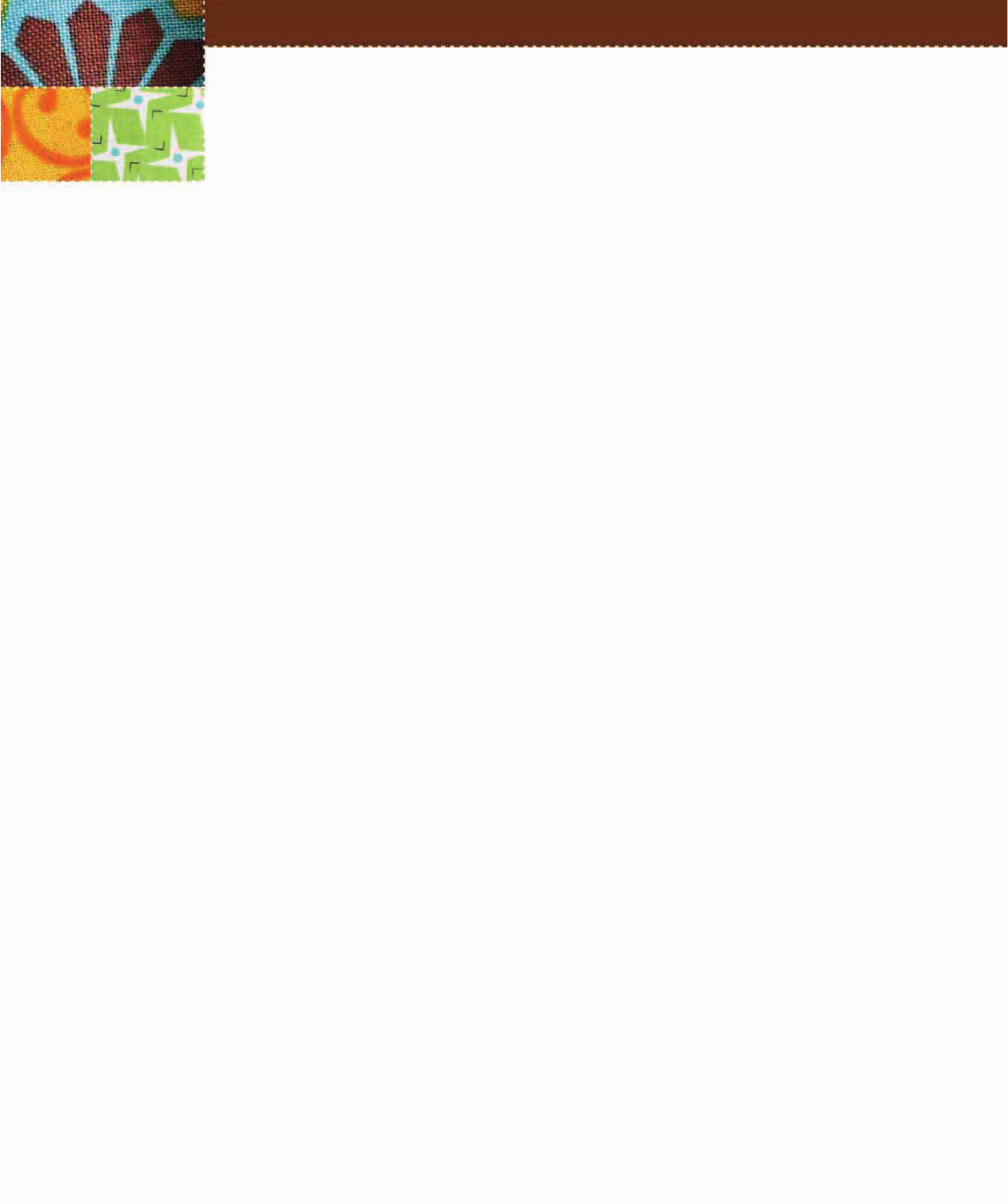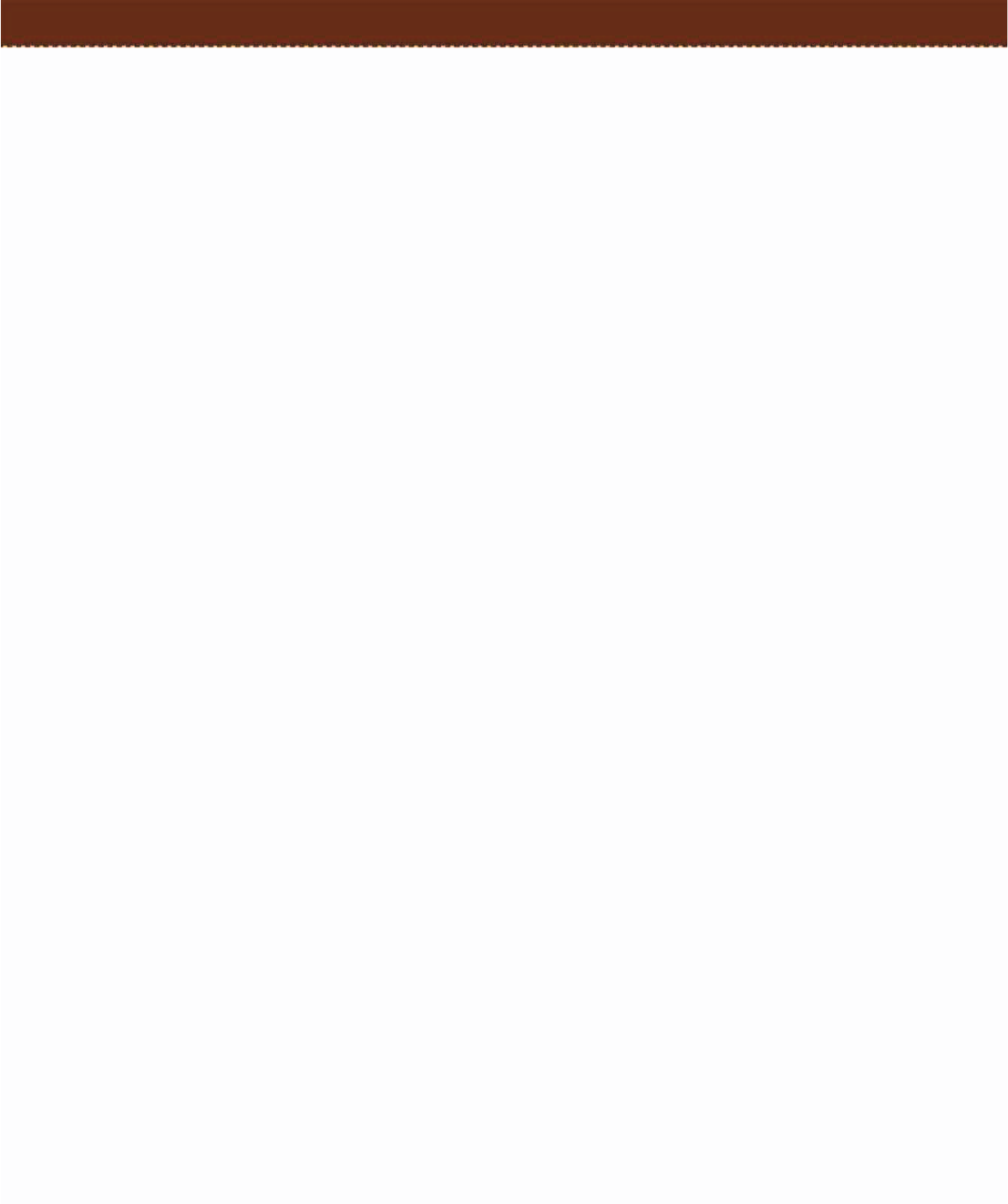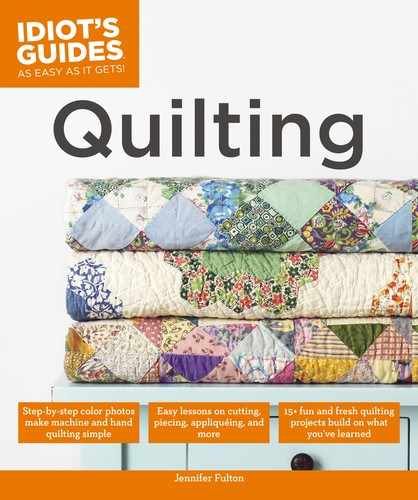
266
GLOSSARY
Glossary
Add-A-Quarter Ruler™ A special ruler designed to
mark an exact
1
⁄
4
-inch (.6 cm) seam allowance.
appliqué A small shape, such as a flower or a heart,
that’s stitched to background fabric to create a quilt
block or border.
background fabric A neutral fabric used throughout
a set of pieced blocks, or behind appliqué pieces in a
set of appliquéd blocks.
backing The bottom layer of a quilt, below the quilt
top and batting. A quilt backing may be pieced or a
single piece of fabric.
baste Loose stitching or pins intended to hold fabric
pieces together temporarily, prior to quilting.
batting The middle layer of a quilt, placed between
the quilt top and the backing. Also known as wadding
or simply batt, batting may be made of cotton, polyes-
ter, wool, silk, bamboo, or other fibers.
bearding Tiny bits of batting that creep through
a quilt top aer quilting. Some batt types are more
prone to bearding than others.
bias The diagonal grain of fabric. Bias is very
stretchy, so you must be careful when sewing along it.
binding A small strip of fabric that’s folded over the
edge of a quilt and sewn down to finish it.
block A quilt is composed of separate quilt blocks,
appliqued or pieced, and sewn together to create a
quilt center.
bobbin-fill A type of bobbin thread specially made
for use with difficult-to-use top threads such as mono-
filament, metallics, and heavy weight threads.
border Fabric that frames the quilt center. Borders
may be pieced or appliquéd, mitered at the corners or
butted (straight).
butted seams A method of joining block units in
which seam allowances are pressed in opposite direc-
tions so they can be nested (butted) together.
chain piecing A method of sewing similar sets of
block units together, in which each set is sewn one
aer the other without stopping.
cornerstones Fabric squares placed where sashing
strips meet.
crosswise grain The grain of fabric that runs per-
pendicular to the selvage edge. Crosswise grain is
slightly more stretchy than lengthwise grain, but not as
stretchy as bias.
cross-wound thread Thread that is wound in a
crossing X pattern on the spool. Load cross-wound
threads horizontally.
custom quilting Quilting in which different patterns
are chosen for the borders, sashing, and blocks. See
also pantograph.
design wall Batting- or flannel-covered panel on
which quilt blocks can be arranged (laid out) prior to
sewing them together.

267
GLOSSARY
dog ears Small triangles that appear at either end of
a seam when triangles, diamonds, and similar shapes
are aligned correctly with other block pieces prior to
sewing.
echo quilting A type of quilting that follows the
edges of appliqué or block shapes.
English paper piecing Method of piecing non-
square shapes. The edges of each shape are turned
under using paper templates, and then the shapes are
whipstitched together and the papers are removed.
feed dogs Part of a sewing machine that grabs the
fabric and feeds it under the needle at an even pace.
If you lower the feed dogs, you can move the fabric in
any direction for free-motion quilting.
flange Special edge treatment for a quilt that uses a
strip of fabric folded in half.
flying geese unit A block unit composed of a single
rectangle, overlaid on both sides by triangles. The
corner triangles are called the “sky,” while the triangle
in the center is known as the “goose.”
foundation paper piecing See paper piecing.
four-patch unit A block unit composed of four
squares.
free-motion quilting Quilting in any direction with
the feed dogs down using an appliqué, darning, or
open-toe foot. See also straight-line quilting.
fusible A web of glue used to iron (fuse) appliqué
shapes to background fabric. Fusibles come in various
types; choose the one that works best for your ma-
chine applique method.
fussy cutting Isolating a specific motif in fabric for
use in a quilt block.
half-square triangles 1. A right-triangle created
by cutting a square in half diagonally. 2. A block unit
composed of two right-triangles that form a square.
Also known as HSTs and triangle squares.
Hera marker A tool used to create temporary creas-
es on a quilt top that can then be followed by hand
quilting.
hourglass unit A block unit composed of triangles
that form two perpendicular hourglass shapes.
HST See half-square triangles.
in the ditch A quilting method in which you quilt in
the seam between blocks or units.
lengthwise grain The grain of the fabric that runs
parallel to the selvage. Lengthwise grain is the least
stretchy grain and is preferred for use in quilt borders.
longarmer Professional quilter who quilts a quilt
using an industrial sewing machine with a long sewing
arm, on a frame on which the quilt is rolled so that a
large section of it can be quilted at one time.
miter A method of joining two edges (such as a
quilt’s binding or border) so they form a perfect
45-degree angle, like a picture frame.
monofilament thread Invisible thread, used in
machine appliqué or machine quilting to create a
hand-appliquéd or hand-quilted look.
nested seams See butted seams.
opposing seams See butted seams.
pantograph An all-over pattern that is quilted back
and forth across a quilt top, without obvious breaks.
See also custom quilting.

268
GLOSSARY
paper piecing Method of constructing a block in
which fabrics are sewn to a paper foundation print-
ed with the block pattern. Also known as foundation
paper piecing.
partial seam A block seam that is sewn only part-
way initially, allowing the rest of the units in a block to
be sewn to a central unit. Aer that, the partial seam is
sewn the rest of the way, completing the seam.
piece To stitch together fabric pieces by hand or
machine.
pillowcase finish A method for finishing the edge of
a quilt without binding.
prairie points Folded fabric triangles used to create
a decorative edge to a quilt or border.
precuts Fabric, oen from a single fabric line, cut
in the sizes of common block units. Common precuts
include Jelly Rolls, Fat Quarters, Fat Eighths, Charm
Packs, and Layer Cakes.
quarter-square triangles Also known as a QST, a
quarter-square triangle is created by cutting a square
in both directions diagonally. See also half-square
triangles.
quilt A quilt consists of three layers: quilt top, bat-
ting, and backing, stitched (quilted) through all layers.
quilt center Composed of quilt blocks and sashing
(if any), but not borders (which are added aer the
center is constructed).
quilter’s knot A special way of forming a knot at the
end of a piece of thread, which involves twisting the
thread around the needle.
quilting The process of stitching the layers of a quilt
(quilt top, batting, backing) together. See also free-
motion quilting and straight-line quilting.
raw edge An unfinished (unsewn) fabric edge.
right side of fabric The printed side of fabric. You
sew block pieces with right sides together (rst). Some
fabrics, such as batiks, do not have a right or wrong
side. See also wrong side of fabric.
rotary cutter Fitted with a sharp circular blade, a
rotary cutter looks like a pizza cutter and is used to
cut fabric by simply rolling over it. Use a rotary cutter
only with special acrylic rulers and a self-healing mat.
RST Short for right sides together. Block pieces are
sewn together aer placing the right sides of the two
pieces together.
sashing Small strips of fabric placed between blocks
in a horizontal or diagonal setting to set them apart. In
a vertical setting, the sashing is wider and sets block
columns apart.
seam allowance Measured from the edge of fabric
to the sewing line. In quilting, the standard seam
allowance is
1
⁄
4
-inch (.6 cm); unfinished units or blocks
are
1
⁄
2
-inch (1.2 cm) bigger than when finished.
selvage The tightly woven edges of fabric yardage,
oen printed with the manufacturer’s name, fabric
line, and the colors used in the fabric.
setting The arrangement of blocks that form the
quilt center. Common settings include horizontal,
vertical, on-point, and medallion.
setting triangles In an on-point (diagonal) setting,
side setting and corner setting triangles are used at
the ends of each row of blocks, to form a straight edge
to the quilt top.
square-in-square A block unit composed of a
square, surrounded by triangles in each corner. Also
known as a diamond-in-a-square unit.

269
GLOSSARY
stabilizer Used to stabilize fabric and prevent puck-
ering when machine appliquéing. Stabilizers come in
cut-away, tear-away, and wash-away forms.
stacked thread Thread that is wound around the
spool in a parallel fashion, so it is stacked on top of the
previous round. Load stacked threads vertically.
staystitch Stitching close to an edge, to stabilize it
and keep it from stretching out of shape.
stencil A pattern used to mark a quilt top for
quilting.
stippling Type of free-motion quilting in
which the quilting line simply meanders around,
filling the space. A larger version of stippling is called
meandering.
straight-line quilting Quilting in straight lines or
so curves with a walking foot. See also free-motion
quilting.
straight-wound thread See stacked thread.
strip set Multiple fabric strips sewn together, and
then subcut into smaller block units such as two-bar
or three-bar units.
subcutting Cutting a fabric strip or strip set into
smaller block units such as squares, rectangles, and
triangles.
template A traceable pattern for block or applique
pieces made from template plastic or freezer paper.
throat plate A sewing machine part through which
the feed dogs and needle move. A zigzag (standard)
throat plate has a horizontal hole and is used in
machine appliqué. A straight-stitch (single hole) throat
plate has a single hole and is used in machine piecing.
triangle square See half-square triangles.
two-bar unit A block unit composed of two rectan-
gles. A similar unit is a three-bar unit, which is com-
posed of three rectangles.
tying a quilt A method for quilting a quilt in which
the layers are tied with crochet thread, perle cotton,
yarn, or embroidery floss in a grid approximately 4
inches (10 cm) apart. See also pillowcase finish.
unit A common part of a quilt block, such as a four-
patch, two-bar, three-bar, flying geese, half-square tri-
angle, square-in-square, or hourglass unit. You create
these common units, and then sew them together to
create a quilt block.
walking foot A sewing machine foot that helps to
feed fabric layers under the needle evenly. Use a walk-
ing foot when straight-line quilting.
WOF Width of fabric; typically 42 or 44 inches
(106.7 or 111.8 cm).
wrong side of fabric The unprinted side of fabric.
See also right side of fabric.
y-seam A y-seam joins three block pieces with inter-
secting seams that together form a “Y” shape.
..................Content has been hidden....................
You can't read the all page of ebook, please click here login for view all page.
